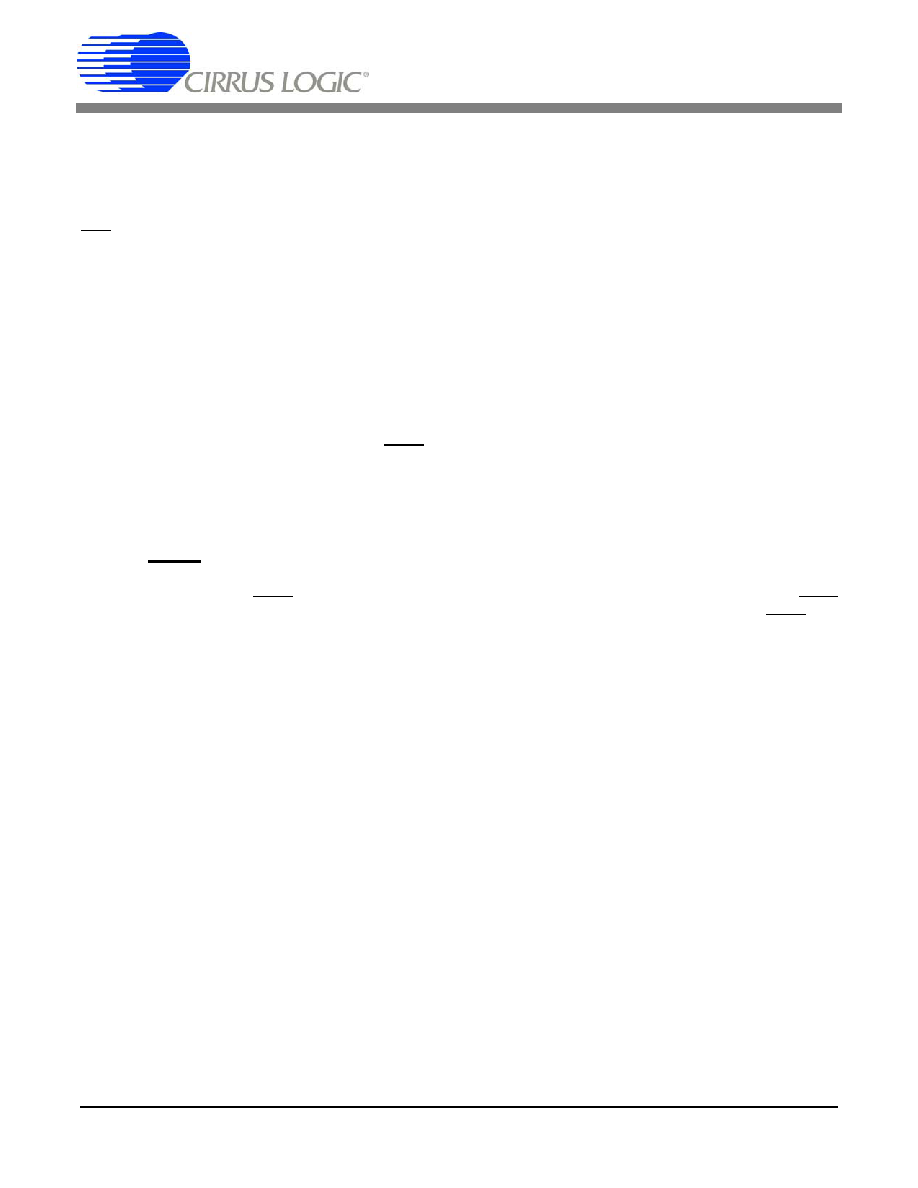- 您现在的位置:买卖IC网 > Sheet目录1991 > CS5361-DZZ (Cirrus Logic Inc)IC ADC AUD 114DB 204KHZ 24-TSSOP

CS5361
DS467F2
19
4.5
High-pass Filter and DC Offset Calibration
The operational amplifiers in the input circuitry driving the CS5361 may generate a small DC offset into the A/D con-
verter. The CS5361 includes a high-pass filter after the decimator to remove any DC offset which could result in re-
cording a DC level, possibly yielding “clicks” when switching between devices in a multichannel system.
The high-pass filter continuously subtracts a measure of the DC offset from the output of the decimation filter. If the
HPF pin is taken high during normal operation, the current value of the DC offset register is frozen and this DC offset
will continue to be subtracted from the conversion result. This feature makes it possible to perform a system DC
offset calibration by:
1) Running the CS5361 with the high-pass filter enabled until the filter settles. See the Digital Filter Character-
istics for filter settling time.
2) Disabling the high-pass filter and freezing the stored DC offset.
A system calibration performed in this way will eliminate offsets anywhere in the signal path between the calibration
point and the CS5361.
4.6
Overflow Detection
The CS5361 includes overflow detection on both the left and right channels. This time multiplexed information is
presented as open drain, active low on pin 15, OVFL. The OVFL_L and OVFL_R data will go to a logical low as soon
as an overrange condition in either channel is detected. The data will remain low as specified in the Switching Char-
acteristics - Serial Audio Port section. This ensures sufficient time to detect an overrange condition regardless of the
speed mode. After the timeout, the OVFL_L and OVFL_R data will return to a logical high if there has not been any
other overrange condition detected. Please note that an overrange condition on either channel will restart the time-
out period for both channels.
4.6.1
OVFL Output Timing
In left-justified format, the OVFL pin is updated one SCLK period after an LRCK transition. In I2S format, the OVFL
pin is updated two SCLK periods after an LRCK transition. Refer to Figures 23 and 24. In both cases the OVFL data
can be easily demultiplexed by using the LRCK to latch the data. In left-justified format, the rising edge of LRCK
would latch the right channel overflow status, and the falling edge of LRCK would latch the left channel overflow
status. In I2S format, the falling edge of LRCK would latch the right channel overflow status and the rising edge of
LRCK would latch the left channel overflow status.
4.7
Grounding and Power Supply Decoupling
As with any high resolution converter, the CS5361 requires careful attention to power supply and grounding arrange-
ments if its potential performance is to be realized. Figure 22 shows the recommended power arrangements, with
VA and VL connected to clean supplies. VD, which powers the digital filter, may be run from the system logic supply
or may be powered from the analog supply via a resistor. In this case, no additional devices should be powered from
VD. Decoupling capacitors should be as near to the ADC as possible, with the low value ceramic capacitor being
the nearest. All signals, especially clocks, should be kept away from the FILT+ and VQ pins in order to avoid un-
wanted coupling into the modulators. The FILT+ and VQ decoupling capacitors, particularly the 0.01 F, must be
positioned to minimize the electrical path from FILT+ and REFGND. The CDB5361 evaluation board demonstrates
the optimum layout and power supply arrangements. To minimize digital noise, connect the ADC digital outputs only
to CMOS inputs.
4.8
Synchronization of Multiple Devices
In systems where multiple ADCs are required, care must be taken to achieve simultaneous sampling. To ensure
synchronous sampling, the MCLK and LRCK must be the same for all of the CS5361’s in the system. If only one
master clock source is needed, one solution is to place one CS5361 in Master mode, and slave all of the other
CS5361’s to the one master. If multiple master clock sources are needed, a possible solution would be to supply all
clocks from the same external source and time the CS5361 reset with the inactive edge of MCLK. This will ensure
that all converters begin sampling on the same clock edge.
发布紧急采购,3分钟左右您将得到回复。
相关PDF资料
CS5364-CQZR
IC ADC 4CH 114DB 216KHZ 48-LQFP
CS5366-DQZR
IC ADC 6CH 114DB 216KHZ 48-LQFP
CS5368-DQZ
IC ADC 8CH 114DB 216KHZ 48-LQFP
CS5381-KSZ
IC ADC AUD 120DB 192KHZ 24-SOIC
CS53L21-CNZR
IC ADC STEREO 24BIT 98DB 32-QFN
CS5509-ASZR
IC ADC 16BIT SGL SUPP 16-SOIC
CS5512-BSZ
IC ADC 20BIT EXTERNAL OSC 8-SOIC
CS5526-BSZR
IC ADC 20BIT W/4BIT LATCH 20SSOP
相关代理商/技术参数
CS5361-DZZR
功能描述:音频模/数转换器 IC IC 24Bit 114dB 192kHz Multi-Bit ADC RoHS:否 制造商:Wolfson Microelectronics 转换速率: 分辨率: ADC 输入端数量: 工作电源电压: 最大工作温度: 最小工作温度: 安装风格: 封装 / 箱体: 封装:
CS5361GD16
制造商:未知厂家 制造商全称:未知厂家 功能描述:Analog IC
CS5361-KSZ
功能描述:音频模/数转换器 IC 24-Bit 114dB 192kHz Multi-Bit ADC RoHS:否 制造商:Wolfson Microelectronics 转换速率: 分辨率: ADC 输入端数量: 工作电源电压: 最大工作温度: 最小工作温度: 安装风格: 封装 / 箱体: 封装:
CS5361-KSZR
功能描述:音频模/数转换器 IC IC 24Bit 114dB 192kHz Multi-Bit ADC RoHS:否 制造商:Wolfson Microelectronics 转换速率: 分辨率: ADC 输入端数量: 工作电源电压: 最大工作温度: 最小工作温度: 安装风格: 封装 / 箱体: 封装:
CS5361-KZ
制造商:Cirrus Logic 功能描述:24-BIT 192KHZ 114DB AUDIO A/D CONVERTER - Rail/Tube
CS5361-KZZ
功能描述:音频模/数转换器 IC 24-Bit 114dB 192kHz Multi-Bit ADC RoHS:否 制造商:Wolfson Microelectronics 转换速率: 分辨率: ADC 输入端数量: 工作电源电压: 最大工作温度: 最小工作温度: 安装风格: 封装 / 箱体: 封装:
CS5361-KZZR
功能描述:音频模/数转换器 IC IC 24Bit 114dB 192kHz Multi-Bit ADC RoHS:否 制造商:Wolfson Microelectronics 转换速率: 分辨率: ADC 输入端数量: 工作电源电压: 最大工作温度: 最小工作温度: 安装风格: 封装 / 箱体: 封装:
CS5363-DZZ
功能描述:模数转换器 - ADC IC 105 dB, 192kHz Stereo A/D conv RoHS:否 制造商:Texas Instruments 通道数量:2 结构:Sigma-Delta 转换速率:125 SPs to 8 KSPs 分辨率:24 bit 输入类型:Differential 信噪比:107 dB 接口类型:SPI 工作电源电压:1.7 V to 3.6 V, 2.7 V to 5.25 V 最大工作温度:+ 85 C 安装风格:SMD/SMT 封装 / 箱体:VQFN-32